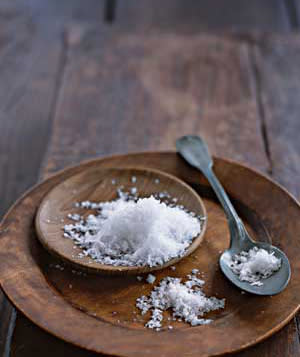6 types of salt and how to use them

Knowing the difference between Kosher and sea salt can make a world of difference in your dishes. Here, six easy-to-find varieties, with tips on when and where to sprinkle them.
Kosher Salt
Use it for: All cooking. Kosher salt dissolves fast, and its flavor disperses quickly, so chefs recommend tossing it on everything from pork roast to popcorn.
Origin: Either the sea or the earth. Widely sold brands include Morton and Diamond Crystal, which are made using different methods. Kosher salt got its name because its craggy crystals make it perfect for curing meat―a step in the koshering process.
Texture: Coarse. Cooks prize crystals like these; their roughness makes it easy to pinch a perfect amount.
To buy: Look in your local supermarket. Kosher salts cost about $1 a pound. If you don't mind a few clumps, buy Diamond Crystal; it has no anticaking agents, which can leave a chemical aftertaste.
Crystalline Sea Salt
Use it for: Adding a pungent burst of flavor to just-cooked foods. These crystals will complement anything from a fresh salad to a salmon fillet.
Origin: Coasts from Portugal to Maine, California to the Pacific Rim.
Texture: Fine or coarse. The size of the irregular crystals affects how fast the salt dissolves. It varies in color, depending on the minerals it contains (iron-rich red clay, for example, gives Hawaiian sea salt a pinkish hue). These natural impurities can add subtly briny, sweet, or even bitter flavors to the salts.
To buy: Check gourmet shops or on-line (thespicehouse.com stocks Hawaiian sea salt). Expect to pay $2 to $15 or more a pound. Many markets sell La Baleine, a relatively inexpensive brand ($3 for 26.5 ounces).
From Real Simple: Upgrade Your Pantry Staples
Flaked Sea Salt
Use it for: Bringing a complex flavor to steamed vegetables or shellfish. Take a pinch, crush the crystals between your fingertips, and let them fall on freshly cooked food. This salt will add a hint of briny flavor.
Origin: England's Essex coast is where the most popular brand, Maldon, is harvested.
Texture: Soft, sheer, pyramid-like flakes. This is the fastest-dissolving of all of the salt grains.
To buy: Search specialty-food stores and the Internet. You'll pay $6 for 8.5 ounces at chefshop.com.
Fleur de Sel
Use it for: A special-occasion table salt. Spoon it into a salt cellar to be pinched, then sprinkled over food just before eating. Delicately flavored, it adds a perfect hint of saltiness to freshly sliced tomato or melon.
Origin: Coastal salt ponds in France. The caviar of sea salt, fleur de sel is hand harvested. Conditions have to be just right (lots of sun and wind) for it to "bloom" like a flower on the surface of the water.
Texture: Crystalline, which means that fleur de sel melts slowly in the mouth. Its earthy, pleasing flavor lingers on the tongue.
To buy: Search specialty-food stores and the Internet (try chefshop.com). From $11 for 4.4 ounces to $45 for 35 ounces.
See Real Simple's The Secret to Good Food
Rock Salt
Use it for: Making ice cream and deicing. Rock salt is paired with ice in old-fashioned hand-cranked ice cream makers to regulate the temperature. You can also use it to deice your sidewalks and driveway in the winter months.
Origin: Mined from deposits in the earth, rock salt is not sold for use directly on food. It's usually packaged in an organic, unprocessed form.
Texture: Large, chunky, nonuniform crystals. Minerals and other harmless impurities can give it a grayish color.
To buy: It's sold in supermarkets and hardware and home stores for less than $1 a pound.
Pickling Salt
Use it for: Brining pickles and sauerkraut. It will also brine a turkey, but beware: Pickling salt is far more concentrated than the more commonly used kosher salt, so you'll need to use less.
Origin: Like table salt, pickling salt may come from the earth or the sea. But unlike table salt, it isn't fortified with iodine (a nutritional need for humans) and doesn't contain anticaking chemicals, both of which would turn pickles an unappetizing color. Virtually 100 percent sodium chloride, it's the purest of salts.
Texture: This variety is fine grained, like table salt.
To buy: Many supermarkets sell it in large boxes or bags, but it can be hard to find in cities. It costs less than $1 a pound.
More from Real Simple:
